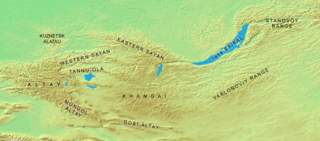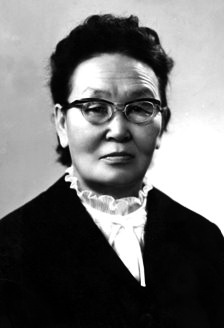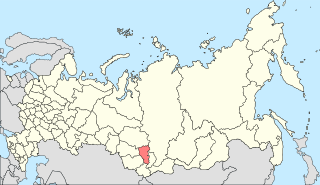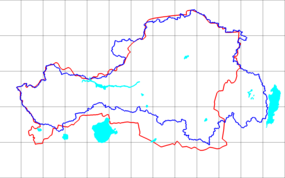
The Tuvan People's Republic or TPR; known as the Tannu Tuva People's Republic until 1926, was a partially recognized state that existed between 1921 and 1944. It was formally a socialist republic and de facto a Soviet puppet state. The TPR was located in Tuva, covering the same territory, north-west of Mongolia, as was the previous 1914–1921 Tuvan protectorate of the former Russian Empire, and is now the Tuva Republic, an administrative part of Russia.

Kyzyl is the capital city of the republic of Tuva, Russia. The name of the city means "red" or "crimson" in Tuvan. Its population was 120,067 (2021 Census);

Tannu Uriankhai was a historical region of the Mongol Empire and, later, the Qing dynasty. The territory of Tannu Uriankhai largely corresponds to the modern-day Tuva Republic of the Russian Federation, neighboring areas in Russia, and a small part of the modern state of Mongolia.

The Tannu-Ola mountains is a mountain range in southern Siberia, in the Tuva Republic of Russia. It extends in an east–west direction and curves along the Mongolian border. Its highest peak reaches 3,061 m (10,043 ft). The Tannu-ola mountains are mentioned in the 13th-century text The Secret History of the Mongols under the name "Tanglu mountains" (唐麓), and also in the JāmiʿAl-tawārīkh of Rashid-al-Din Hamadani (1247–1318) under the name "Toungat mountains" (تنغات). By the Qing dynasty the name has been changed to Tangnu (唐努) mountains, from which the modern name is derived. All names are probably rooted in the old Turkic word taŋ - "wonder, awe, wondrous."

Tuva or Tyva, officially the Republic of Tuva, is a republic of Russia. Tuva lies at the geographical center of Asia, in southern Siberia. The republic borders the Altai Republic, Khakassia, Krasnoyarsk Krai, Irkutsk Oblast, and Buryatia in Russia, and shares an international border with Mongolia to the south. Tuva has a population of 336,651. Its capital is the city of Kyzyl.
Tooruktug Dolgai Tañdym is a Tuvan folk song. It was first adopted in 1944 as the national anthem of the Tuvan People's Republic (TPR) when Tuva was an independent socialist republic recognised only by the Soviet Union and the Mongolian People's Republic. Later in the same year following the Soviet annexation of Tuva, the country was then incorporated into the USSR and thus became the Tuvan Autonomous Oblast (TAO). In 1961, the political status of the region was upgraded to the Tuvan Autonomous Soviet Socialist Republic, yet the anthem still remained.

Khertek Amyrbitovna Anchimaa-Toka was a Tuvan and Soviet politician who was the Chairwoman of Little Khural of the Tuvan People's Republic from 1940 to 1944, and was the first non-royal female head of state. She was the wife of Salchak Toka, who was the republic's supreme leader from 1932 to 1973.

Donduk Kuular was a Tuvan monk, politician, and prime minister of the Tuvan People's Republic.

The occupation of Outer Mongolia by the Beiyang government of the Republic of China after the revocation of Outer Mongolian autonomy began in October 1919 and lasted until 18 March 1921, when Chinese troops in Urga were routed by Baron Roman von Ungern-Sternberg's White Russian and Mongolian forces. These, in turn, were defeated by the Red Army and its Mongolian allies by June 1921.

South Central Siberia is a geographical region north of the point where Russia, China, Kazakhstan and Mongolia come together.

The Mongolian Revolution of 1921 was a military and political event by which Mongolian revolutionaries, with the assistance of the Soviet Red Army, expelled Russian White Guards from the country, and founded the Mongolian People's Republic in 1924. Although nominally independent, the Mongolian People's Republic was a satellite state of the Soviet Union until the third Mongolian revolution in January 1990. The revolution also ended the Chinese Beiyang government's occupation of Mongolia, which begun in 1919. The official Mongolian name of the revolution is "People's Revolution of 1921" or simply "People's Revolution".

The Bogd Khanate of Mongolia was the government of Outer Mongolia between 1911 and 1919 and again from 1921 to 1924. By the spring of 1911, some prominent Mongol nobles including Prince Tögs-Ochiryn Namnansüren persuaded the Jebstundamba Khutukhtu to convene a meeting of nobles and ecclesiastical officials to discuss independence from Qing China. On 30 November 1911 the Mongols established the Temporary Government of Khalkha. On 29 December 1911 the Mongols declared their independence from the collapsing Qing dynasty following the outbreak of the Xinhai Revolution. They installed as theocratic sovereign the 8th Bogd Gegeen, highest authority of Tibetan Buddhism in Mongolia, who took the title Bogd Khan or "Holy Ruler". The Bogd Khaan was last khagan of the Mongols. This ushered in the period of "Theocratic Mongolia", and the realm of the Bogd Khan is usually known as the "Bogd Khanate".

The Tuvan People's Republic issued postage stamps between 1926 and 1936. They were popular with stamp collectors in the Western world in the mid-twentieth century because of the obscurity and exoticism of Tannu Tuva and the stamps' quirky, colorful designs. The validity of many stamps purportedly issued by Tannu Tuva has been questioned by philatelists.

The territory currently known as Tuva has been occupied by various groups throughout its history. Sources are rare and unclear for most of Tuva's early history. Archeological evidence indicates a Scythian presence possibly as early as the 9th century BC. Tuva was conquered relatively easily by the succession of empires which swept across the region. It was most likely held by various Turkic khanates until 1207. It was then ruled by various Mongol-led regimes until the 18th century, when it submitted to the Manchu-led Qing dynasty. Slow Russian colonization during the 19th century led to progressive annexation of the region to Russia in the 20th century. The region was then controlled by the Russian Empire and the Soviet Union before finally joining the Russian Federation in 1992. Throughout this whole time, the borders of Tuva have seen very little modification.

The 1929 Tuvan coup d'état took place in the Tuvan People's Republic. It occurred in January after the Tuvan government under Prime Minister Donduk Kuular attempted to implement nationalist, religious and anti-Soviet policies, including making Tibetan Buddhism the official religion. With support from the Soviet Union, five Tuvan youths successfully overthrew the government, and one of them, Salchak Toka, became supreme ruler as General Secretary of the Central Committee of the Tuvan People's Revolutionary Party. They quickly reversed Donduk's policies and brought the republic closer to the Soviet Union. The Tuvan People's Republic later joined the Soviet Union in 1944.

The Uryankhay Republic was a nominally independent state that broke away from the Qing dynasty of China during the Xinhai Revolution. It was proclaimed as a republic in 1911 by the Tuvan separatist movement and was encouraged by the Russian Empire. On 1 December 1911, Outer Mongolia declared independence from Qing China. Throughout the rest of December, bands of Uriankhai began to plunder and burn Chinese-owned shops.

The Tuvan People’s Republic entered World War II on the side of the Allied Powers, shortly after the invasion of the Soviet Union by Nazi Germany that broke the non-aggression pact between the Soviet Union and Third Reich.

The Tuvan People's Revolutionary Army (TNRA) (Russian: Тувинская народно-революционная армия; Tuvan: Тываның Араттың Революстуг Шерии) was the military wing of the Tuvan People's Revolutionary Party which constituted the armed forces of the Tuvan People's Republic.
Anarchism in Mongolia was present during the revolutionary period of the 1910s and 1920s, closely linked with the Russian anarchist movement in Altai, Buryatia and Tuva.


















